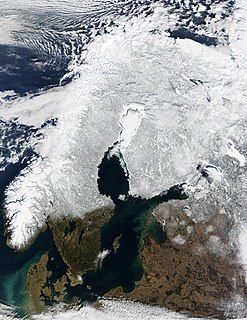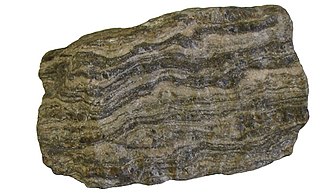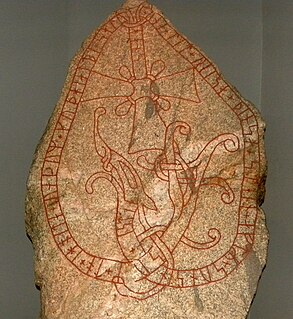
Uppland Runic Inscription 613, also known as the Torsätra runestone, is the Rundata catalog number for a Viking Age memorial runestone originally located in Torsätra, which is approximately 8 kilometers northeast of Bro, Stockholm County, Sweden, which is in the historic province of Uppland.

The Näsby Runestone, designated as U 455 under the Rundata catalog, is a Viking Age memorial runestone that is located in Näsby, Uppland, Sweden.

The Granby Runestone, designated as U 337 under the Rundata catalog, is one of the longest Viking Age runic inscriptions located in Uppland, Sweden.

Uppland Runic Inscription 100 is the Rundata designation for a memorial runestone that is located in the forest where a path meets a bog near Skälby, which is about two kilometers northeast of Sollentuna, Stockholm County, Sweden, which was part of the historical province of Uppland.
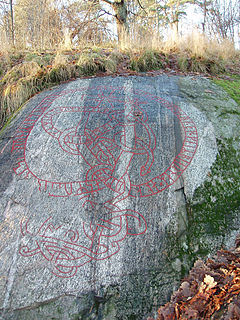
Runic inscription U Fv1986;84 is the Rundata catalog number for a Viking Age memorial that is located at Bo gård on the island of Lidingö in Uppland, Sweden.

Uppland Runic Inscription 308 or U 308 is the Rundata catalog designation for a memorial runestone that is located in Ekeby, Stockholm County, Sweden, which was in the historic province of Uppland. While the tradition of carving inscriptions into boulders began in the 4th century and lasted into the 12th century, most runestones date from the late Viking Age.
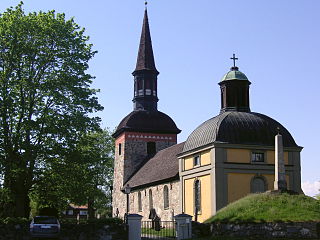
The Lovö Runestones are five Viking Age memorial runestones that are located outside the Lovö church on the island of Lovön in Lake Mälaren, which is in Stockholm County, Sweden, and in the historic province of Uppland.

Runic inscription U 873 is the Rundata catalog number for a Viking Age memorial runestone that is located in Örsunda, which is about one kilometer west of Örsundsbro, Uppsala County, Sweden, which is in the historic province of Uppland.

Uppland Runic Inscription Fv1946;258 or U Fv1946;258 is the Rundata catalog designation for a Viking Age memorial runic inscription to two fathers that is located in Fällbro, which is about 5 kilometers northwest of Täby, Stockholm County, Sweden, which is in the historic province of Uppland.

This runic inscription, designated as U Fv1948;168 in the Rundata catalog, is on a Viking Age memorial runestone to two sons that is located in Alsike, Uppsala County, Sweden, which is in the historic province of Uppland.
The Lilla Vilunda runestones are three Viking Age memorial runestones that were erected by members of the same family and which are located at Lilla Vilunda in Upplands Väsby, Stockholm County, Sweden, and in the historic province of Uppland.

The Björklinge runestones are five Viking Age memorial runestones designated in the Rundata catalog as U 1045, U 1046, U 1047, U 1048, and U 1050 that are located at the church in Björklinge, Uppsala County, Sweden, which is in the historic province of Uppland. In addition, there is a small fragment of a runestone with a partial runic text i * lit * rita * meaning "had erected" that has been given the catalog number U 1049.

Uppland Runic Inscription 227 or U 227 is the Rundata catalog designation for a Viking Age memorial runestone that is located in Grana, which is about 4 kilometers west of Vallentuna, Stockholm County, Sweden, and in the historic province of Uppland.

Uppland Runic Inscription 1146 or U 1146 is the Rundata catalog designation for a Viking Age memorial runestone that is located in Gillberga, which is about 1 kilometer east of Tierp, Uppsala County, Sweden, which is in the historic province of Uppland.

Uppland Runic Inscription 80 or U 80 is the Rundata catalog listing for a Viking Age memorial runic inscription that is located in Sundby, which is in Solna Municipality, Stockholm County, Sweden, and in the historic province of Uppland.

Uppland Runic Inscription 993 or U 993 is the Rundata catalog number for a Viking Age memorial runestone located in Brunnby, which is one kilometer west of Gunsta, Uppsala County, Sweden, which was part of the historical province of Uppland.

Uppland Runic Inscription Fv1953;263 or U Fv1953;263 is the Rundata catalog listing for a Viking Age memorial runestone that was discovered at Helenelund, which is in Sollentuna, Stockholm County, Sweden, which was in the historic province of Uppland.

Uppland Runic Inscription 171 or U 171 is the Rundata catalog listing for a Viking Age memorial runestone that is located in Söderby, which is four kilometers west of Vaxholm, Stockholm County, Sweden, and in the historic province of Uppland.
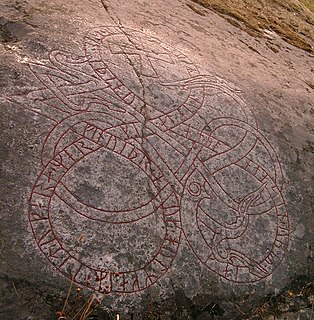
Uppland Runic Inscription 210 or U 210 is the Rundata catalog listing for a Viking Age memorial runic inscription which is carved on a rock-face that is located in Åsta, which is three kilometers east of Vallentuna, Stockholm County, Sweden, and in the historic province of Uppland. The inscription is signed by the runemaster Öpir.

The Bolsta Runestones are two Viking Age memorial runestones and two fragments of a third that are located in Bolsta, which is on the east edge of Uppsala, Uppsala County, Sweden, and in the historic province of Uppland. One runestone is signed by the runemaster with the normalized name of Åsmund Kåresson and the other by the runemaster named Öpir.

